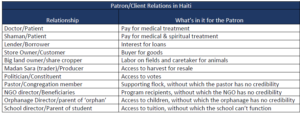As seen in here, few if any rural households in rural Haiti would risk dependence on a single source of food or income. Most have gardens and livestock, some depend in part on fishing, many will readily engage in opportunities such as glass eels, growing vetiver, working as temporary day laborers in the fields of a neighbor, transporting produce to a market or the city or building a house. Almost all women in rural Haiti engage in some kind of trade, whether selling a stable grain out of their house, candy crackers, bread and cookies off the front porch or in front of a local primary school, selling rum or cigarettes at the Sunday cock fight, selling small daily harvests from their garden at the local market, or engaging intensive itinerant trade in a local produce. Many households also have members who engage in skilled craft production, house construction, and medicinal and spiritual specialties (see Occupational Multiplicity in Haiti). Whatever they do to earn money, an over-riding rule in popular class Haiti is dependence on simplistic, locally procured technology and tools and near-0 investment, near-0 risk, a strategy summarized elsewhere in a diagram I call the Cake of Vulnerability. In the present article, however, I focus on another layer to vulnerability and social security in Haiti, the second-tier security net of social capital.
Households in Haiti tend to be kinship based. Members of the household are related to one another, either directly or fictively through marriage. But while networks might overlap, each contributing household member has his or her own specific network of family, friends, associates and in many cases lovers who facilitate access to resources such as loans, jobs, favors or, as in the case of remittances and foreign aid or provide direct transfers of goods or cash. Some of these linkages are familial or sexual, others are patron-client, meaning that the “giver” or “patron” has a superior social position and the “receiver” or “client” is conceptualized as a dependent. The dependency nature of the relationship is quite often publicly recognized and even emphasized by the client who will commonly refer to the patron literally as “patwon.” Nevertheless, although the Patron might get prestige and social recognition for his or her status, the Patron is also dependent on the client’s support, without which a patron would not be able to function. Reinforcement for familial ties do not need elaboration, but the most common patron-client linkages and the material logic that reinforces them are defined in the table below. In every case the client stands to benefit, as when a store owner extends credit, a doctor delays payment for treatment, or a trader loans money to a needed farmer who will later sell her his harvest, or a pastor shares food aid or used clothing with his ‘flock’, an orphanage owner shares “sponsorship” money from overseas with a parent in exchange for including the parents child on the orphanage role. But what might no be so intuitively clear and what I highlight in the table is ‘what’s in it for the patron.’

The linkages above are often difficult to quantify and just as difficult to gather data on. For familial and sexual ties, people are often not inclined to divulge to strangers or even neighbors and friends their access to remittances, help from urban family or secret lovers, or to evaluate the extent of assistance that a relative, friend, mate or secret lover would be inclined and capable of providing assistance in the event of a crisis. The Patron-Client relation can also be difficult to measure as people are similarly not inclined to reveal access to credit, money owed or the goods that are being share with them from gatekeepers of aid (orphanage, school and NGO directors). Access to land from a patron, credit from a shaman or doctor, and trade agreements between producers and female itinerant merchants might even have been made under the assurance of secrecy so not to incite resentment or jealousy from others.








